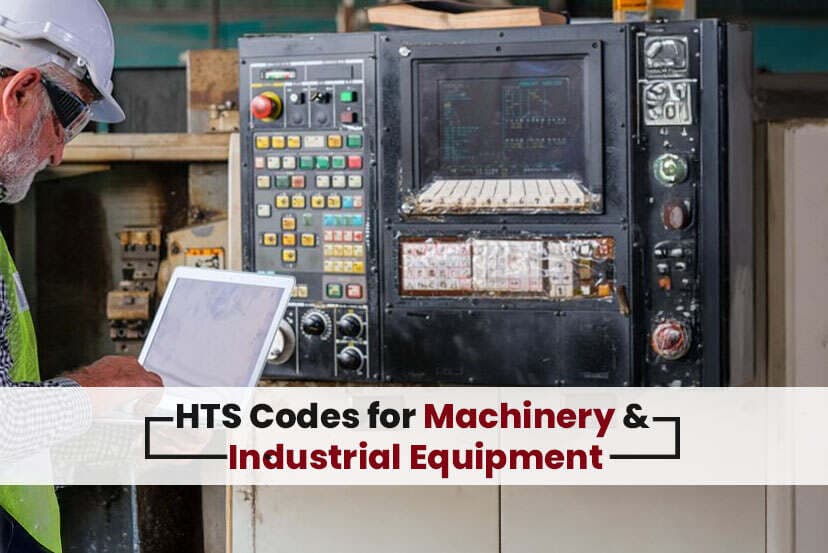When engaging in international trade, it is necessary to properly classify machinery and industrial equipment under the Harmonized Tariff Schedule codes for compliance and duty costs, as well as to facilitate the customs clearing process. Industrial, machinery, and equipment can range in category from packaging machines to power generation equipment. Correct classification under HTS is critical, as many machines and equipment may appear to share classifications but must comply with HTS rules in different ways.
This article will provide you with in-depth information and analysis regarding HTS codes for industrial machinery, outlining the chapters you need to pay attention to, the classification principles applicable, and best practices for importers and exporters.
Understanding the Framework of HTS Codes for Industrial Machinery
The HTS is an organized product classification system for manufactured goods that is based on HS codes developed by the World Customs Organization, or “WCO.” Countries build on the six-digit HS codes to create more detailed national HTS codes, which apply to machinery and industrial equipment. You will mainly see machinery codes in the following chapters:
- Chapter 84: Nuclear reactors, boilers, machinery, and mechanical appliances, and other parts.
- Chapter 85: Electrical machinery and equipment and their parts.
The majority of HTS codes for industrial equipment and machines are outlined within these two chapters.
Chapter 84: Mechanical Industrial Equipment and Machinery
Chapter 84 is a broad classification category of mechanical industrial equipment that encompasses various types of equipment used in multiple sectors, including engines, pumps, compressors, and machine tools. It also embraces packaging machines, HVAC equipment, and various types of manufacturing equipment. Significant industrial equipment tariff code categories include:
- Boilers and Reactors (8401-8403): Includes a range of industrial nuclear reactors and steam boilers.
- Engines, Motors (8406-8411): This covers internal combustion engines, turbines, and electric motors.
- Pumps, Compressors, Fans, and Blowers (8413-8414): Covering centrifugal pumps, air or gas compressors.
- Industrial Air Conditioning and Refrigeration (8415): Machines designed to cool and ventilate for use in production.
- Machine Tools for Shaping Materials (8456-8466): Covers lathes, milling machines, drilling machines, and other related items for shaping materials in manufacturing.
- Packaging Machinery (8422): Machinery designed to fill, seal, wrap, label, or bottle products.
The aforementioned Harmonized Tariff Schedule machinery codes can be significant in tariff determinations.
Chapter 85: Electrical Machinery and Components
Chapter 85 addresses electrical equipment used to power or that works in conjunction with industrial machinery, including the following equipment:
- Electric Motors and Generators (8501-8503): Equipment used to convert electrical energy to mechanical energy or mechanical energy to electrical energy.
- Transformers and Power Converters (8504-8507): Equipment that is used to assist in power management in industrial applications.
- Electrical Control Gear and Parts: Important equipment for machine automation and safety for operating equipment.
Industries refer to these classification codes for importing and classifying electrical components to be used in the operation of machinery.
Key Principles for Machinery HTS Code Classification
Classifying industrial machinery under the tariff code requires examining several factors. Key factors include:
- Basic Functionality: The basic operation of the machine or equipment (i.e., pump, compressor, packaging).
- Power Source: Electric, pneumatic, hydraulic, and combustion-powered machinery may be listed differently in the subheadings.
- Intended Use: The use of equipment is an important consideration, whether it is sector-specific (i.e., packaging, manufacturing, or agricultural equipment).
- Parts and Components: There are subtitled subheadings that break the parts and components up that are specifically for certain machines or types of machines (Chapters 84 and 85).
- Machine Complexity Level: The class is going to differ depending on whether the tool is simple or fully automated.
Making sure that the HTS codes for industrial machinery are identified properly will help with the appropriate tariff and compliance with any regulations.
Why HTS Codes Matter for Machinery Importers?
Accurate classification of the HTS code for machinery matters because:
- Correct Duty Assessment: The industrial equipment tariff code varies greatly, often dependent on classification, which can directly affect the inherited cost.
- Trade Compliance: Customs will clear products only after classification points to the correct HTS number. This will help to save the importer from incurring hefty fines or delays to reclaim their freight.
- Eligibility for Trade Agreements: Accurate HTS codes will determine whether importers can access the preferential duty rates that can be determined by trade agreements like the USMCA or CAFTA.
- Statistical Accuracy: Governments use HTS for statistical analysis to monitor import volumes. Statistics shape trade policy and industrial statistics.
- Better Logistics: Well-classified HTS shipments will streamline customs inspections and documentation about the imported products.
HTS Code for Packaging Machinery: Detailed Guideline
Packaging machinery is a specific subsection of industrial machinery because its uses and applications are unique. The packaging machinery refers to machinery that carries out operations of:
- Wrapping, bottling, labeling, and filling across many different entering segments: food, pharmaceutical, and consumer goods.
- Equipment could be manual, semi-automatic, or automatic, which allows customs to classify the equipment in a number of different ways.
- The classification of the equipment is also based on both the type of item being packaged and the type of packaging.
Improper classification of the HTS code for importing machinery for industrial purposes can also carry penalty costs for misclassification.
Challenges in Machinery HTS Classification for 2025
The growing complexity of machinery creates complications for determining the HTS code for industrial equipment. Key challenges include:
- Hybrid Machines: Equipment with both functions and power modes (electric and hydraulic) complicates the classification process.
- Smart Equipment: The use of IoT, digital controls, and capabilities requires an update to tariff and customs procedures.
- Sustainable Machinery: Sustainable machinery, which includes machinery to save energy or that is made of sustainable materials, may determine the cost of the tariff, but requires a sustainable justification classification.
- Customs More Diligent in Enforcement: Increased enforcement requires accurate and well-supported HTS classification to prevent audits and penalties.
Businesses should make an effort to actively keep track of changes and their compliance.
Best Practices for Correct HTS Classification for Industrial Machines
To achieve accurate HTS codes for industrial machinery, companies need to do the following:
- Make use of official HTS resources, including the USITC Harmonized Tariff Schedule, and WCO resources documenting updates.
- Discuss your classification with customs brokers or trade compliance professionals if it is not commonly used equipment or involves borderline classifying situations.
- Document everything in a well-organized manner, such as the manufacturer’s data sheet and certificate of origins.
- Be conscious of codes to be ready for any reclassification from either new tariffs or customs ruling determinations.
Streamlined Trade through Correct Machinery HTS Classification
In the ever-changing trade environment of 2025, familiarity with HTS codes for industrial machinery is crucial to reduce financial exposure and aid in the customs clearance of machinery and industrial equipment. Having a detailed understanding gives importers certainty in the correct tariff classification of even the most challenging machines, such as packaging equipment. This is a very important area for manufacturing companies to keep their operations running efficiently.
Frequently Asked Questions
- Are parts classified separately in the HTS for machinery?
Yes, parts typically have separate codes, particularly for electric and mechanical components.
- How can I ensure correct HTS classification for complex machinery?
You should review the official tariffication for guidance and seek support from your customs expert who reviews technical specifications.
- Do HTS codes affect eligibility for trade agreements?
Absolutely. When you get the code correct, you can benefit from preferential tariff rates (agreement rates) like USMCA or CAFTA.





